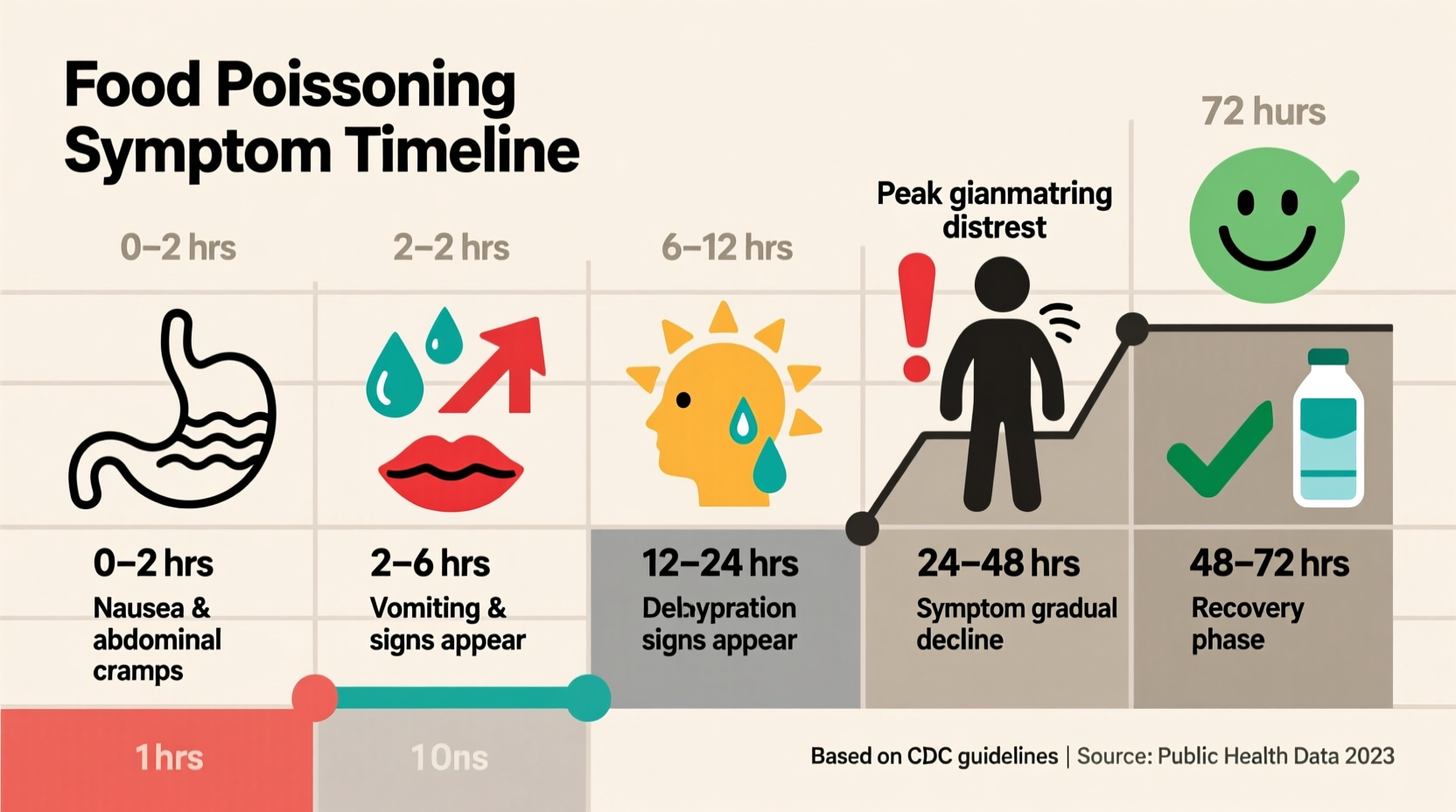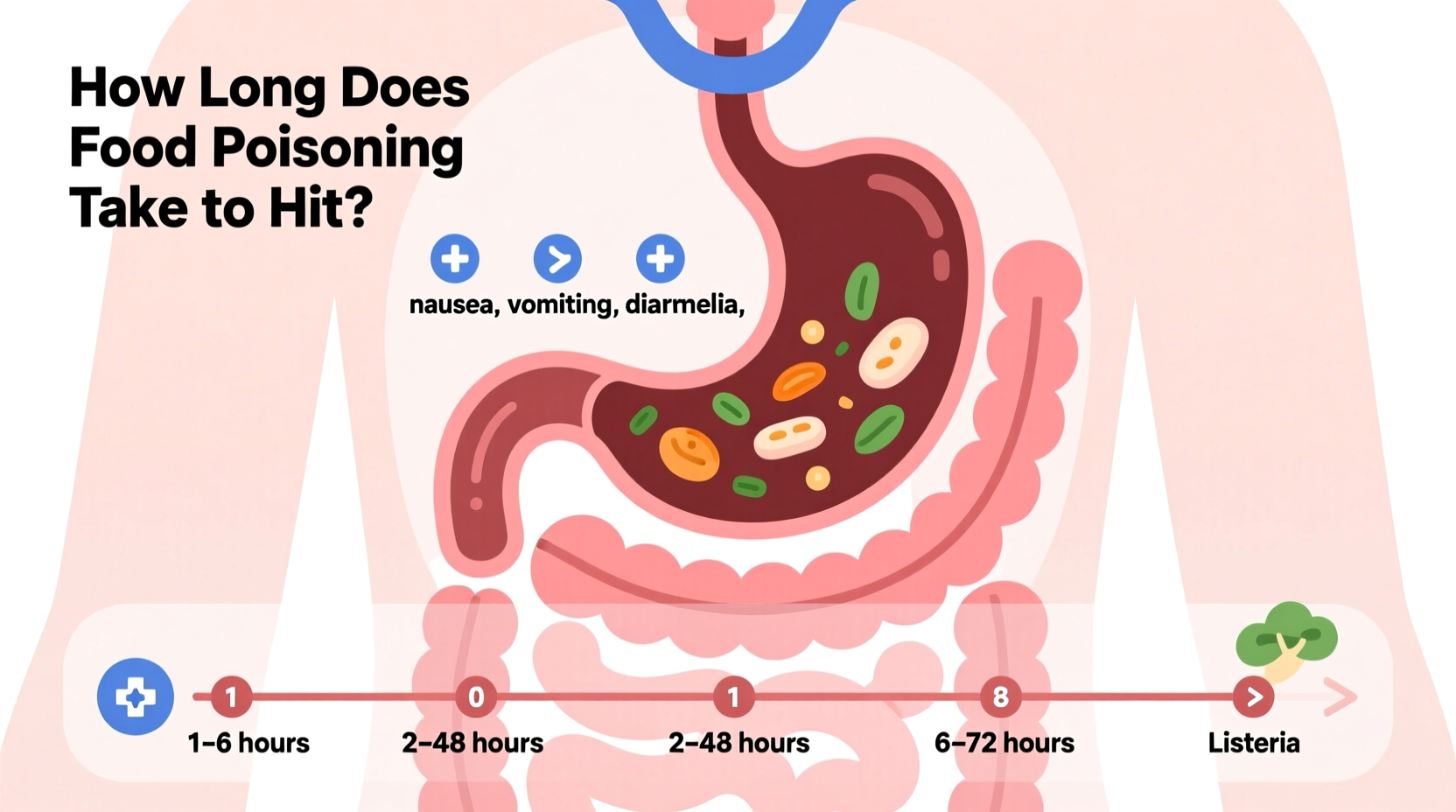Most food poisoning symptoms begin 6 to 24 hours after consuming contaminated food, though the exact timeframe varies significantly depending on the specific pathogen. Bacterial causes like Staphylococcus aureus can trigger symptoms in as little as 30 minutes, while others like hepatitis A may take up to 28 days to manifest.
Experiencing stomach cramps after a meal and wondering how long does it take for food poison to hit? You're not alone. Each year, 1 in 6 Americans suffers from foodborne illness, making timely recognition critical for proper treatment. Understanding the precise food poisoning incubation period helps distinguish between a simple stomach bug and something requiring medical attention.
What Determines Food Poisoning Onset Time?
The timeframe for food poisoning symptoms depends primarily on the contaminant type. Different pathogens multiply at varying rates and produce toxins with distinct mechanisms. While most cases develop within 24 hours, the specific timeframe for food poisoning symptoms ranges dramatically:
| Pathogen Type | Typical Onset Time | Common Sources |
|---|---|---|
| Staphylococcus aureus | 30 minutes - 8 hours | Deli meats, salads, pastries |
| Bacillus cereus | 1-16 hours | Rice dishes, leftovers |
| Salmonella | 6-72 hours (avg 12-36) | Raw eggs, poultry, produce |
| E. coli O157:H7 | 1-10 days (avg 3-4) | Undercooked beef, raw milk |
| Campylobacter | 2-5 days | Raw poultry, unpasteurized milk |
| Hepatitis A virus | 15-50 days (avg 28) | Contaminated water, shellfish |
This food poisoning onset time by bacteria type comparison comes from CDC surveillance data tracking over 250 foodborne pathogens. The variation explains why two people eating the same contaminated meal might experience symptoms at completely different times.
Symptom Progression Timeline: What to Expect
Once symptoms begin, the progression follows a predictable pattern for most bacterial infections. Understanding this how soon after contaminated food do you get sick sequence helps manage expectations:
- 0-6 hours: Rapid-onset toxins (like staph) cause sudden nausea, vomiting, and cramps
- 6-24 hours: Most common window for initial symptoms including diarrhea and fever
- 24-72 hours: Peak severity with potential dehydration from persistent vomiting/diarrhea
- 3-7 days: Gradual improvement as immune system clears infection
- 7+ days: Concerning if symptoms persist (may indicate complications)
According to FDA Food Code guidelines, the "danger zone" for bacterial growth occurs between 40°F and 140°F (4°C-60°C). Foods held in this temperature range for more than 2 hours multiply pathogens exponentially, directly impacting the food poisoning incubation period.

When Timing Matters: Critical Warning Signs
While most cases resolve within 48-72 hours, certain symptoms require immediate medical attention regardless of onset time. The how long after eating bad food do symptoms appear question becomes secondary when these red flags emerge:
- Signs of severe dehydration (dark urine, dizziness, dry mouth)
- Blood in vomit or stool
- High fever above 102°F (38.9°C)
- Symptoms lasting longer than 3 days
- Numbness or muscle weakness
The CDC emphasizes that infants, elderly individuals, and immunocompromised patients should seek care immediately if food poisoning is suspected, as their food poisoning onset time may be complicated by underlying health conditions.
Preventing Food Poisoning: Practical Steps
Understanding the timeframe for food poisoning symptoms helps, but prevention remains your best defense. Implement these evidence-based practices:
- Temperature control: Keep cold foods below 40°F and hot foods above 140°F
- Proper storage: Refrigerate leftovers within 2 hours (1 hour if above 90°F)
- Cross-contamination prevention: Use separate cutting boards for raw meats and produce
- Thorough cooking: Verify internal temperatures (poultry 165°F, ground meats 160°F)
- Hand hygiene: Wash hands for 20 seconds with soap before handling food
Research from the Journal of Food Protection shows these simple measures reduce foodborne illness risk by up to 70%. Remember that the food poisoning incubation period doesn't change prevention fundamentals—proper food handling remains essential regardless of pathogen type.
When to Contact a Healthcare Provider
While most food poisoning cases resolve without treatment, consult a medical professional if:
- Symptoms begin within 30 minutes (suggesting possible chemical contamination)
- Vomiting prevents keeping liquids down for 12+ hours
- Diarrhea persists beyond 2 days
- You've recently traveled internationally
- You consumed high-risk foods like raw shellfish or unpasteurized dairy
Early intervention becomes crucial when dealing with pathogens that have longer food poisoning onset time periods, as delayed symptoms might indicate more serious infections requiring specific treatments.
How long after eating contaminated food do symptoms typically appear?
Most food poisoning symptoms begin 6-24 hours after exposure, though this varies by pathogen. Staphylococcus can cause symptoms in 30 minutes, while hepatitis A may take up to 28 days to manifest.
Can food poisoning symptoms appear the same day?
Yes, certain pathogens like Staphylococcus aureus and Bacillus cereus can trigger symptoms within 30 minutes to 8 hours. This rapid onset often indicates preformed toxins rather than bacterial growth in the body.
What factors affect how quickly food poisoning symptoms develop?
The contaminant type, amount consumed, individual immune status, and stomach acidity all influence onset time. Food temperature history (time spent in danger zone) significantly impacts pathogen load and subsequent symptom timing.
When should I seek medical help for suspected food poisoning?
Seek immediate care if you experience blood in vomit/stool, signs of severe dehydration, high fever above 102°F, symptoms lasting beyond 3 days, or neurological symptoms like blurred vision or muscle weakness.
Does cooking contaminated food eliminate food poisoning risk?
Not always. While proper cooking kills bacteria, some pathogens produce heat-stable toxins that remain dangerous even after cooking. This explains why reheating contaminated food doesn't always prevent illness with certain pathogens like Staphylococcus aureus.











 浙公网安备
33010002000092号
浙公网安备
33010002000092号 浙B2-20120091-4
浙B2-20120091-4